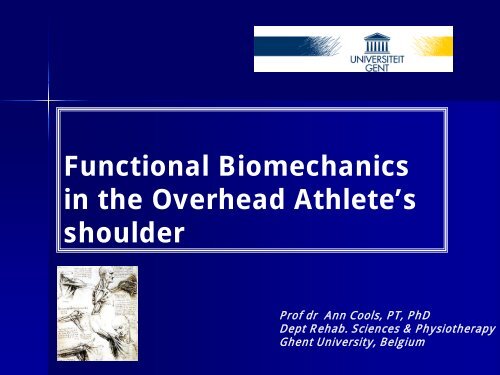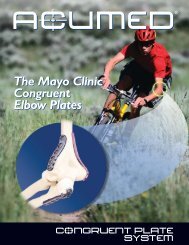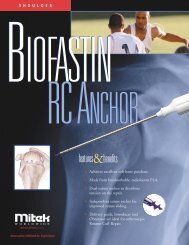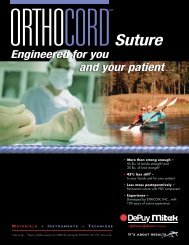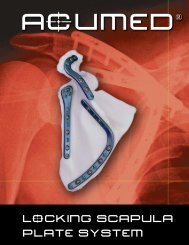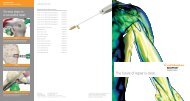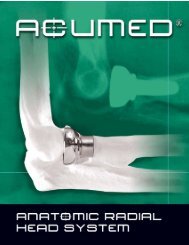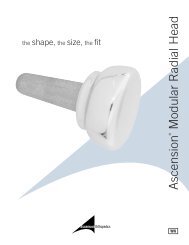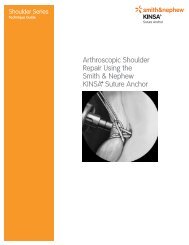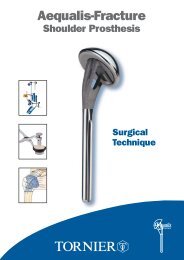Functional Biomechanics of the Overhead athletes shoulder
Functional Biomechanics of the Overhead athletes shoulder
Functional Biomechanics of the Overhead athletes shoulder
You also want an ePaper? Increase the reach of your titles
YUMPU automatically turns print PDFs into web optimized ePapers that Google loves.
<strong>Functional</strong> <strong>Biomechanics</strong>in <strong>the</strong> <strong>Overhead</strong> Athlete’s<strong>shoulder</strong>Pr<strong>of</strong> dr Ann Cools, PT, PhDDept Rehab. Sciences & Physio<strong>the</strong>rapyGhent University, Belgium
Shoulder kinematics:Importance <strong>of</strong> muscle action• Role <strong>of</strong> <strong>the</strong> static stabilizers?Limited static articular constraints inglenohumeral and scapulothoracic jointWrightington Sports Shoulder Conference 2009
Shoulder kinematics:Importance <strong>of</strong> muscle action• Role <strong>of</strong> <strong>the</strong> physical trainer/physio<strong>the</strong>rapist:Muscle function can be changed bypreventive <strong>of</strong> rehabilitation exercisesWrightington Sports Shoulder Conference 2009
Force-couples• Muscles withdifferent/oppositeaction• Working toge<strong>the</strong>r• Specific action• <strong>Functional</strong>stability andperformanceWrightington Sports Shoulder Conference 2009
Glenohumeral force couples• Transversal plane: Rotator cuffmuscles centre humeral head inglenoid fossaWrightington Sports Shoulder Conference 2009
Glenohumeral force couples• Rotator cuff activity duringoverhead throwing:– compressive force during cocking– Stretch-shortening cycle internal rotatorsWrightington Sports Shoulder Conference 2009
Glenohumeral force couples• Rotator cuff activity duringoverhead throwing:– compressive force during deceleration– Eccentric activity external rotatorsWrightington Sports Shoulder Conference 2009
Glenohumeral force couples• Normal values: normal musclebalance ER/IR = 65% (Bak et al. 1997)• Lower ratio increases risk for <strong>shoulder</strong>injury (Ellenbecker et al. 2004, Wilk et al. 2002)Wrightington Sports Shoulder Conference 2009
Glenohumeral force couples• Sport-specific adaptation?:– Relative strong internal rotators– Relative weak external rotators– Decreased ER/IR ratio(Baltaci et al. 2003, Wang et al. 2000, Gozlan et al. 2005)Wrightington Sports Shoulder Conference 2009
Glenohumeral force couples• frontal plane: rotator cuff versusdeltoid muscleWrightington Sports Shoulder Conference 2009
Glenohumeral force couples• Translation forces duringthrowing?Wrightington Sports Shoulder Conference 2009Fleisig 1996
Glenohumeral force couples• Normal values & sport-specificadaptation?– No data on optimal ratio RC/Deltoid– Strength training increases deltoidstrength– Relative weakness <strong>of</strong> rotator cuff muscles– Increased risk for impingementWrightington Sports Shoulder Conference 2009
Scapulothoracic force couplesUT + SA:MOVEMENTLT:Wrightington Sports Shoulder Conference 2009MOVEMENTREGULATION
(Johnson Clin Biomech 1994)• Upper trapeziusUpward rotation +elevation• Serratus AnteriorUpward rotation +protraction• Lower trapeziusStability andmovement controlWrightington Sports Shoulder Conference 2009
scapulothoracic force couples• Scapular muscle activityduring overhead throwing?– Upward rotation (UT+SA) during stride– Retraction (trap) during cockingWrightington Sports Shoulder Conference 2009
scapulothoracic force couples• Scapular muscle activity duringoverhead throwing?– Powerful protraction during acceleration (SA)– Eccentric activity trapezius duringdeceleration & follow-throughWrightington Sports Shoulder Conference 2009
scapulothoracic force couples• Normal values & sport-specificadaptation?– Ratio in non-athletic population = 1 (Cools et al. 2004)– <strong>Overhead</strong> <strong>athletes</strong>: changes in protraction /retraction ratio, however no consensus(Wilk et al. 2002, Cools et al. 2005,Myers et al. 2005, Su et al. 2004)– Adaptations probably are sports-specific– Injured <strong>athletes</strong>: decreased Lower Trapeziusactivity and timing properties (Cools et al. 2003,2007) and serratus anterior dysfunction (Pink2000, Cools et al. 2004)Wrightington Sports Shoulder Conference 2009
Conclusion <strong>of</strong> thispresentation• Muscle activity extremely important forfunctional stability and sports performance• Muscle balance more important thanisolated muscle strength• Glenohumeral:– External rotators versus internal rotators– Rotator cuff versus deltoid• Scapulothoracic:– Trapezius versus serratus anterior– Lower versus upper trapeziusWrightington Sports Shoulder Conference 2009


